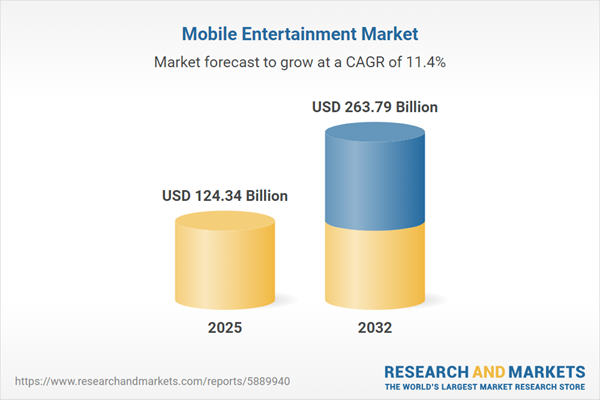Speak directly to the analyst to clarify any post sales queries you may have.
The mobile entertainment market is rapidly evolving, with new technologies fundamentally changing how content is delivered and consumed on smartphones, tablets, and connected devices. Decision-makers face a dynamic landscape shaped by shifting consumer preferences, advanced digital capabilities, and emerging regulatory pressures.
Market Snapshot: Mobile Entertainment Market Growth and Trajectory
The Mobile Entertainment Market grew from USD 111.39 billion in 2024 to USD 124.34 billion in 2025. It is expected to continue growing at a CAGR of 11.37%, reaching USD 263.79 billion by 2032. This expansion reflects rising demand for immersive content and seamless cross-device experiences. As market penetration matures in established regions, the competitive landscape intensifies, prompting innovation in content, platform design, and monetization strategies.
Scope & Segmentation: Unpacking Mobile Entertainment Ecosystems
- Content Types: Ebooks and audiobooks (including AI-generated audio and subscription e-reading), mobile games (spanning casual, social casino, hyper-casual, esports, mobile AR esports, and cloud-based AAA titles), music streaming (ad-supported services, immersive audio, subscription offerings), social media entertainment (AR social experiences, live streaming, short-form video), and video streaming (ad-supported VoD, interactive formats, bundled and standalone SVOD, transactional VoD).
- Monetization Models: Advertising (with an emphasis on programmatic methods), in-app purchases (cosmetic items, loot boxes), paid downloads, and subscriptions (including hybrid models blending free and paid tiers).
- Platform Types: Foldable devices, smartphones, tablets, wearables—each bringing distinct user interactions and capabilities to the ecosystem.
- Regions Covered: Americas (including North America, Latin America), Europe, Middle East & Africa (Western Europe, Middle East, Africa), and Asia-Pacific (including key high-growth and established markets).
- Key Companies: Analysis covers strategic movements by Tencent Holdings Limited, NetEase, Inc., Activision Blizzard, Inc., Sea Limited, Electronic Arts Inc., Zynga Inc., Ubisoft Entertainment SA, Take-Two Interactive Software, Inc., Com2uS Corp., and GungHo Online Entertainment, Inc.
- Technology Focus: Artificial intelligence, augmented reality, low-latency cloud infrastructures, immersive audio, and advanced networking technologies such as 5G and edge computing are shaping future mobile content delivery and consumption experiences.
Key Takeaways: Strategic Insights for Senior Decision-Makers
- Mobile devices now serve as the central platform for consuming music, games, interactive stories, and live video. Content providers are innovating to deliver high-fidelity, personalized, and on-demand experiences that keep users engaged.
- The convergence of AI and machine learning is enabling the creation of dynamic, context-aware audio content, improved media recommendations, and streamlined user journeys, paving the way for deeper user relationships and greater retention.
- Rapid adoption of augmented reality and immersive audio elevates the storytelling canvas, supporting richer entertainment formats and enabling differentiated product offerings.
- As traditional hardware-based innovation slows in saturated regions, companies are diversifying revenue through hybrid monetization—integrating ad-supported, in-app purchase, and subscription models to address varied audience preferences and maximize returns.
- Market players are shifting focus toward cross-platform development and flexible content architectures, preparing for rapid transitions in consumer technology adoption and regulatory change.
- Regional trends illustrate the critical need to localize offerings, align with evolving privacy and data regulations, and form strategic alliances that balance global reach with cultural resonance.
Tariff Impact: Navigating Cost Structures and Supply Chain Adjustments
New United States tariffs introduced in 2025 have significantly impacted the cost dynamics of mobile entertainment devices and associated technologies. Additional duties on imported chipsets, displays, and electronics raise manufacturing expenses, driving producers to diversify supply chains and pursue regionalization. In response, firms explore alternative sourcing, negotiate bulk agreements with local suppliers, and invest in onshore assembly. Shifts in strategy have led to modified pricing models and increased focus on cloud-based solutions that prioritize recurring revenue streams while lessening hardware dependence.
Methodology & Data Sources: Rigorous, Multi-Layered Approach
This analysis integrates primary research from executive interviews, product managers, and key technology partners, capturing qualitative insights into digital entertainment strategies. Supported by secondary research—reviewing financial disclosures, regulatory filings, and industry publications—findings are validated through statistical modeling and peer review to uphold accuracy, transparency, and objectivity across all market assessments.
Why This Report Matters: Actionable Outcomes for Leaders
- Gain a clear understanding of high-growth segments, technology trends, and evolving consumer behaviors driving the mobile entertainment market.
- Identify the operational and strategic priorities required to maintain competitive differentiation and respond to tariff, supply chain, and localization challenges.
Conclusion
This report arms senior decision-makers with comprehensive insights into the technologies, business models, and industry shifts shaping the future of mobile entertainment. By leveraging segment analysis and regional intelligence, leaders can make targeted investments and guide their organizations through rapid market evolution.
Additional Product Information:
- Purchase of this report includes 1 year online access with quarterly updates.
- This report can be updated on request. Please contact our Customer Experience team using the Ask a Question widget on our website.
Table of Contents
3. Executive Summary
4. Market Overview
7. Cumulative Impact of Artificial Intelligence 2025
Companies Mentioned
The companies profiled in this Mobile Entertainment market report include:- Tencent Holdings Limited
- NetEase, Inc.
- Activision Blizzard, Inc.
- Sea Limited
- Electronic Arts Inc.
- Zynga Inc.
- Ubisoft Entertainment SA
- Take-Two Interactive Software, Inc.
- Com2uS Corp.
- GungHo Online Entertainment, Inc.
Table Information
| Report Attribute | Details |
|---|---|
| No. of Pages | 180 |
| Published | October 2025 |
| Forecast Period | 2025 - 2032 |
| Estimated Market Value ( USD | $ 124.34 Billion |
| Forecasted Market Value ( USD | $ 263.79 Billion |
| Compound Annual Growth Rate | 11.3% |
| Regions Covered | Global |
| No. of Companies Mentioned | 11 |









